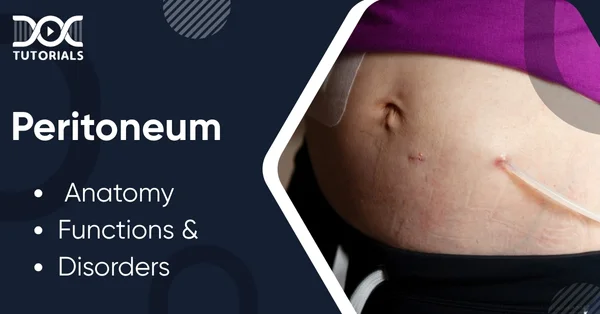Peritoneum | Anatomy, Functions, and Disorders

The peritoneum is a unique serous membrane that covers most of the organs in the abdominal cavity and lines it. It protects organs, maintains their stability, and secretes serous fluid to ensure that digestion and breathing are easy and smooth. If you’re a medical student getting ready for the NEET PG exam, you need to know what the peritoneum is.
This piece covers the structure, function, and typical issues that affect the peritoneum. It is a wonderful place to start learning about this essential clinical anatomy topic. For a more in-depth look, keep reading!
What is the Peritoneum?
The peritoneum is a thin, continuous membrane that surrounds the abdominal cavity and the organs inside it. It performs important functions, including keeping these organs safe and insulated, maintaining their proper position, and producing a fluid that reduces friction as the organs move.
The parietal peritoneum covers the walls of the abdominal and pelvic cavities, and the visceral peritoneum covers the organs in the abdomen. The fluid that enables this smooth interaction is found in the peritoneal cavity, located between the two layers of peritoneum.
The Peritoneum’s Structure
How the Peritoneum Is Made
The peritoneum is a type of serous membrane that produces a fluid called serous fluid, which helps organs and tissues move smoothly. It is composed of mesothelium, a type of tissue that lines various body cavities. The top layer is made up of epithelial cells, and the bottom layer is made up of connective tissue.
The epithelial layer helps in the production and absorption of fluids, making it easier for blood vessels, lymphatics, and nerves to pass through. It also helps eliminate things that are bad for you. The connective tissue layer holds the peritoneal layers and other structures together, giving them structural support.
Some organs are free to move around in the peritoneal cavity, whereas others are attached to the abdominal wall.
Where the Peritoneum Is
The peritoneum is inside the abdominopelvic cavity, which runs from the diaphragm above to the pelvic floor below. This cavity includes both the pelvic and abdominal areas. The parietal peritoneum covers the walls of this whole area.
The visceral peritoneum surrounds numerous vital organs in the abdomen, including the stomach, liver, spleen, and portions of the small and large intestines. Intraperitoneal organs are those that are inside the visceral peritoneum, whereas retroperitoneal organs are those that are outside or behind it.
Making of the Peritoneum
The visceral peritoneum wraps around internal organs, forming two layers and creating distinct pockets. The omentum, a large flap, hangs in front of the abdominal cavity like an apron.
The mesentery is another structure located at the back and holds the intestines in place against the back wall of the abdomen. These two layers contain adipose tissue, which provides insulation and protection. They also serve as pathways for blood vessels, lymphatics, and nerves that nourish the organs in the abdomen.
Nerve Supply to the Peritoneum
The visceral peritoneum, which surrounds the organs in the abdomen, gets its autonomic nerve supply from the same places as those organs. Because of this, it can sense visceral pain, which is often difficult to describe and diagnose.
It reacts to stretching, such as when gas or food makes the digestive tract swell, and to chemicals, like bile or blood leaking. On the other hand, the parietal peritoneum has the same somatic nerves as the abdominal wall it covers. This allows it to perceive pain, temperature, and pressure in a very specific way.
What Does the Peritoneum Do?
The peritoneal cavity is crucial to the body, as it serves several functions, including providing insulation, immunity, lubrication, and structural support. These activities are explained in more detail below:
Immunity
Specialised cells in the peritoneal cavity help the body fight off dangerous germs and viruses that may enter through the digestive tract. This defensive role is crucial for preventing infections and maintaining overall health.
Insulation
The peritoneal cavity helps maintain the temperature of the organs in the abdomen at a stable level, allowing them to function properly. It protects the organs from variations in body temperature.
Form
The cavity holds the abdominal organs in place and provides them with the necessary nutrients to remain healthy. Many organ systems would struggle to function effectively without this framework.
Greasing
The peritoneal cavity lets forth a fluid that helps the organs move smoothly and without pain by reducing friction between them. This lubrication reduces the risk of injury or inflammation that can occur when organs move during digestion and other biological processes.
What are the Most Common Problems With the Peritoneum?
Several medical conditions can cause damage to the peritoneum. Each one is different and requires immediate medical attention. The following lists some common problems:
Cancer
Peritoneal carcinomatosis is the name for when cancer in the abdominal or pelvic organs spreads easily to the peritoneum. In some cases, cancer starts in the peritoneum itself. Some examples are peritoneal mesothelioma and primary peritoneal carcinoma.
Pseudomyxoma peritonei is another unusual type that produces a jelly-like mucus, which fills the peritoneal cavity. Peritoneal cancers often spread to nearby organs, which makes both treatment and prognosis more difficult.
Peritonitis
Peritonitis is the swelling of the peritoneal lining, which is usually caused by an infection in the peritoneal cavity. It could also be a sign of certain gastrointestinal problems that are developing.
Because the peritoneal membrane is highly absorbent, infections in this area can quickly spread to the bloodstream, potentially causing sepsis. Because of this, peritonitis needs to be treated right away by a doctor.
Hernia
When internal tissue pushes through a weak spot in the abdominal wall, it causes a hernia. The peritoneum is often involved, either because the tissue is being displaced or because the lining of an organ is protruding through.
Hernias don’t normally hurt the peritoneum directly, but if the tissue that has herniated is strangled, it can cut off its blood supply and cause problems. Often, surgery is necessary.
Lymphadenitis in the Mesentery
Lymph nodes in the mesentery become bigger and inflamed in this syndrome. It often occurs in response to an infection, and the affected lymph nodes actively filter out microorganisms.
Fever and stomach ache are common symptoms. The ailment usually doesn’t last long and has no long-term effects.
Adhesions in the Abdomen
When surgeons cut through the peritoneum, it can cause fibrous bands to form, known as abdominal adhesions. These bands can make it hard for abdominal organs to move normally, even if they don’t usually cause symptoms.
If adhesions form in critical areas, they can cause problems such as intestinal obstruction, which prevents food from passing through the body normally.
Sclerosing Mesenteric Panniculitis (Mesenteritis)
This uncommon disorder affects the fat tissue of the mesentery, which is a fold of the peritoneum that holds the small intestine in place. The illness causes long-term inflammation, which can lead to scarring or the development of fibrosis.
Although the specific reason remains unknown, this scarring can block blood flow and potentially damage or obstruct the bowel.
Ascites
Ascites occurs when fluid abnormally accumulates in the peritoneal cavity. It typically causes the stomach to swell significantly.
This problem often happens when liver disease gets worse, like cirrhosis, which raises the pressure in the portal vein and causes blood vessels to leak. Sometimes, ascites can also happen as a side effect of heart failure or some types of malignancy.
How Do You Find Out Whether You Have Peritoneal Disorders?
To figure out what’s wrong with the peritoneum, doctors use both clinical evaluation and specialised diagnostic tests, as described below:
Laparoscopy
Laparoscopy is one of the most effective ways to directly visualise the abdominal cavity without requiring a large incision. A small tube with a camera on it is inserted through a small incision, allowing the doctor to view the peritoneal surface.
During this surgery, doctors can take tissue samples (biopsies) for lab investigation, which can help confirm certain peritoneal disorders.
Examination of the Body
A comprehensive physical exam is crucial for identifying issues with the peritoneum. Medical experts look for indicators of underlying pathology in the abdomen, such as discomfort, oedema, or other visible abnormalities. A stethoscope is also often used to listen for any strange sounds coming from the bowels.
Techniques for Imaging
Ultrasound, X-rays, and CT (computed tomography) scans are all types of diagnostic imaging that can provide valuable information about the state of the peritoneum. These techniques help identify abnormalities, such as fluid collections, masses, or structural issues like tumours and cysts.
FAQs About the Peritoneum
- How does the peritoneum help the body’s immune system?
The peritoneum protects the body by keeping infections in one place in the abdominal cavity. The peritoneal lining contains macrophages that actively combat pathogens, and the larger omentum can migrate toward areas of infection or inflammation and attach itself to them, thereby halting the spread of harmful chemicals.
- What does the peritoneal cavity do?
The peritoneal cavity is the empty space that lies between the parietal and visceral layers of the peritoneum. It has a thin layer of serous fluid in it that acts as a lubricant, allowing the organs of the abdomen to move smoothly against each other while they perform functions such as breathing and digesting food.
- Can you live after having your peritoneum taken out?
When the peritoneum is afflicted by serious disorders like peritoneal mesothelioma, it may need to be surgically removed. This is called peritonectomy. It is possible to live after surgery, but whether or not to have surgery relies on a medical examination and how bad the disease is.
Conclusion
The peritoneum is a vital part of the body that helps protect organs, support the immune system, maintain lubrication, and maintain the structural integrity of the abdominal cavity.
For proper diagnosis and successful therapy, it is essential to understand its architecture, physiological functioning, and associated diseases. To excel on the NEET PG exam and in your future clinical work, it is essential to have a solid understanding of these concepts.
DocTutorials has NEET PG study materials, top-notch video lectures, QRP (Quick Revision Programs), and more to help you learn more about this subject.
Want to get the highest score on the NEET PG? Sign up for our NEET PG course today!
Latest Blogs
-

NEET SS Exam 2024: Analysis, Key Dates, Counselling
The NEET SS 2024 exam kicked off on March 29, 2025. Over two days and two slots, candidates across 13…
-

NEET PG Registration 2025: An Essential Guide For Exam Prep
The NEET PG registration, which is conducted online, is a crucial step in the exam process. Filling out the NEET…
-

NEET PG Syllabus 2026: A Must-Have Complete Guide for Exam Success
The NEET PG Syllabus acts as one of the foundation stones for aspiring postgraduate medical students like you who are…




